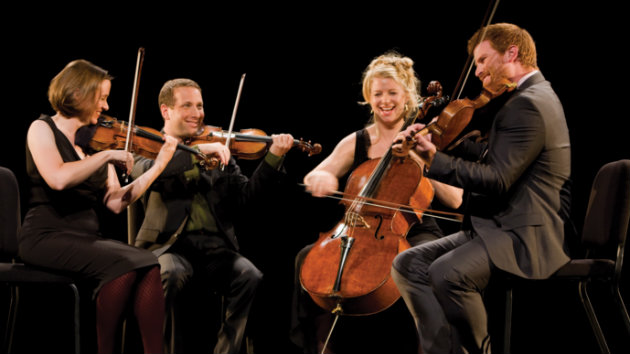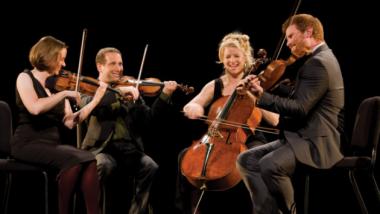
Attending a concert can sometimes feel somewhat artificial: You go to a formal venue to hear musicians engaging in their art, in the company of hundreds (or thousands) of relative strangers — it is a highly contrived and manufactured experience.
Last Saturday’s Salon Series concert by the Cypress String Quartet was nothing like that.
The performance at the intimate auditorium of the Kanbar Performing Arts Center in San Francisco followed the conventions of a contemporary concert. But with the members of CSQ only inches away from an audience of friends and long-time supporters, the concert’s organic and direct personal impact increased dramatically.
CSQ, which consists of Cecily Ward and Tom Stone (violins); Ethan Filner (viola); and Jennifer Kloetzel (cello), had engaged their friends and colleagues Zuill Bailey (cello) and Barry Shiffman (viola) to perform the two string sextets that composer Johannes Brahms created as his Opus 18 and 36.
Brahms wrote these sextets in 1860 and 1864-5 respectively. He was a perfectionist who was extremely self-critical as a composer. In his attempts to compose a string quartet — for many composers the highest and most difficult form of music writing — he found that he needed more options in harmony, color, and symphonic texture to express himself. With two violins, violas, and cellos each, the string sextet gave Brahms enough possibilities: He did not, indeed, publish the first of a total of three string quartets until his Opus 51, in 1873, claiming to have destroyed or abandoned 20 previous attempts.
With six hard-working, deeply engaged musicians literally at arm’s length, the atmosphere is thick with vibrating air; you can not only hear the strings resonating, but even feel the sound waves permeate your body, like music by osmosis.With six hard-working, deeply engaged musicians literally at arm’s length, the atmosphere is thick with vibrating air; you can not only hear the strings resonating, but even feel the sound waves permeate your body, like music by osmosis.
Also part of the experience is the extraneous sounds that musicians make when playing their instruments: fingers sliding across strings, the soft rustling of clothing or feet moving across the carpet, bodily gestures or intakes of breath for emphasis or phrasing.
And then there are the eyes. Follow the musicians’ eyes and you follow the music and the instruments’ forever changing roles. Within Brahms’ musical fabric, they are constantly shape-shifting, moving from lead voice to rhythmic punctuation or countermelody, sometimes from one note to the next. This is especially prevalent in Opus 36, where Brahms’ writing is even more dense and complex than in the First Sextet, with its more Classical orientation.
Needless to say, this performance of both Brahms’ Sextets by “Cypress Plus Two” was one of the finest examples of chamber string ensemble playing I have ever attended; one for the history books and my list of personal favorites.
It is unfortunate and at the same time understandable that CSQ has decided to disband after 20 fruitful years of playing together, but most good things must come to an end.
Based on last Saturday’s performance and the plans for the months ahead until the farewell concert on June 26, CSQ is going out with a bang.

